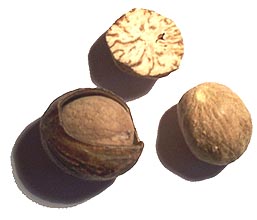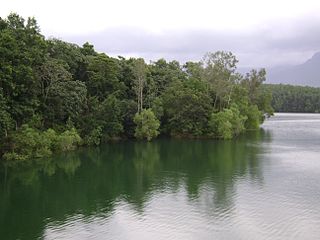
Nutmeg is the seed or ground spice of several species of the genus Myristica. Myristica fragrans is a dark-leaved evergreen tree cultivated for two spices derived from its fruit: nutmeg, from its seed, and mace, from the seed covering. It is also a commercial source of an essential oil and nutmeg butter. The California nutmeg, Torreya californica, has a seed of similar appearance, but is not closely related to Myristica fragrans, and is not used as a spice. Indonesia is the main producer of nutmeg and mace.

Myristica is a genus of trees in the family Myristicaceae. There are over 150 species, distributed in Asia and the western Pacific.

The Myristicaceae are a family of flowering plants native to Africa, Asia, Pacific islands, and the Americas and has been recognized by most taxonomists. It is sometimes called the "nutmeg family", after its most famous member, Myristica fragrans, the source of the spices nutmeg and mace. The best known genera are Myristica in Asia and Virola in the Neotropics.

Kulathupuzha is a Largest Township in the eastern part of (Quilon)Kollam district in Kerala, India.One of the Largest Panchayat in the district and State by area. This town is situated on the Thiruvananthapuram – Shenkottai "SH-2" road State Highway-2 and Thiruvananthapuram-Kasaragod "SH-59/ROUTE 59" State Highway-59. Kulathupuzha is 62 km away from Thiruvananthapuram, 58 km away from Kollam and 9 km from Thenmala eco tourism

Monodora myristica, the calabash nutmeg, is a tropical tree of the family Annonaceae or custard apple family of flowering plants. It is native to Angola, Benin, Cameroon, the Central African Republic, the Democratic Republic of the Congo, Equatorial Guinea, Gabon, Ghana, Guinea-Bissau, Ivory Coast, Kenya, Liberia, Nigeria, the Republic of the Congo, Sierra Leone, Sudan, Tanzania, Togo and Uganda. In former times, its seeds were widely sold as an inexpensive nutmeg substitute. This is now less common outside its region of production. Other names of calabash nutmeg include Jamaican nutmeg, African nutmeg, ehuru, ariwo, awerewa, ehiri, airama, African orchid nutmeg, muscadier de Calabash and lubushi.

Monodora is a genus of plant in family Annonaceae. It contains approximately 15 species, distributed throughout tropical Africa.

Myristica dactyloides is a species of plant in the family Myristicaceae. It is endemic to Sri Lanka. Some sources have it as a synonym of Myristica malabarica.

Myristica malabarica is a species of plant in the family Myristicaceae. It is endemic to the Western Ghats in southwest India. It is threatened by habitat loss according to the IUCN Red List. It can reach up to 25 m long and its bark is greenish black, smooth and sometimes reddish.
Myristica maxima is a species of plant in the family Myristicaceae. It is found in Peninsular Malaysia, Singapore and Borneo.
Myristica yunnanensis is a species of plant in the family Myristicaceae. It is found in southern Yunnan, China, northern Thailand, and in Thanh Hóa Province, Vietnam. It is a large, evergreen tree, up to 30 m (98 ft) tall.
Neuburgia tubiflora is a species of plant in the Loganiaceae family. It is endemic to Papua New Guinea.

The Peppara Wildlife Sanctuary is a wildlife sanctuary in Thiruvananthapuram district of Kerala, India. It consists of the catchment area of the Karamana River, which originates from Chemmunjimottai, the tallest hill within the sanctuary. The sanctuary is named after the Peppara Dam, commissioned in 1983 to augment the drinking water supply to Thiruvananthapuram city and suburban areas. Considering the ecological significance of the area, it was declared a sanctuary in 1983. The terrain is undulating with elevation ranging from 100 m to 1717 m. The area of the sanctuary is 75 km2 with tropical moist evergreen forests and myristica swamps. It is part of the Agasthyamala Biosphere Reserve. Peppara Wildlife Sanctuary is 44 kilometres (27 mi) by car from the nearest railway station, at Thiruvananthapuram, and 49 kilometres (30 mi) from the Thiruvananthapuram airport.

Myristica fragrans is an evergreen tree indigenous to the Moluccas of Indonesia. It is important as the main source of the spices nutmeg and mace. It is widely grown across the tropics including Guangdong and Yunnan in China, Taiwan, Indonesia, Malaysia, Grenada in the Caribbean, Kerala in India, Sri Lanka and South America.

Macelignan (Anwulignan) is a lignan. It can be found in Myristica fragrans, the nutmeg.

Buddleja tubiflora is endemic to much of northern Argentina, southern Paraguay, and southern Brazil, where it grows at the edge of woodlands, thickets, and in old fields, at low elevations. The species was first named and described by George Bentham in 1846

Myristica swamps are a type of freshwater swamp forest predominantly composed of species of Myristica. These are found in three localities in India. Myristica swamps have adapted to inundation by way of stilt roots and knee roots. Myristica swamps are found in the Uttara Kannada district of Karnataka State and in the southern parts of Kerala State. Recently it is found in village bambarde,in Maharashtra's Sindhudurga district.

Hymenocallis tubiflora is a plant species from Trinidad and northern South America. It is reported from Trinidad, Venezuela, Guyana, Suriname, French Guiana, and northern Brazil. The name was originally coined in 1812, the description based on a specimen grown at Kew Botanical Garden in London, the bulb having been seized by British sailors from a French ship captured by the Royal Navy in 1803.

Echinopsis tubiflora, is a species of Echinopsis found in Argentina.
Philotheca tubiflora is a species of flowering plant in the family Rutaceae and is endemic to Western Australia. It is a compact, much-branched with more or less cylindrical leaves and white to pale pink flowers arranged singly on the ends of branchlets. It is only known from the western edge of the Great Victoria Desert.













